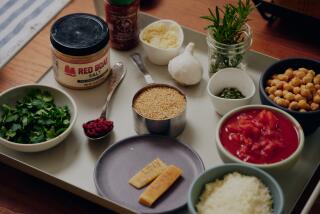Cooking With Secret Ingredients
- Share via
We use two basic senses to appreciate flavors: taste and smell. Our sense of smell excites our sense of taste, and when both senses are excited, the food we eat tastes better.
When we use more than one flavor ingredient in preparing a dish, they play primary and secondary roles. Primary flavors are the obvious ones that give a dish its principal taste, like the tarragon in a chicken tarragon.
But tarragon needs secondary ingredients--a hint of celery seed and anise, for example--to make it interesting and complex, ironically, to make it taste more like tarragon.
Secondary flavors are secret ingredients. Using only one herb or spice to achieve a certain taste usually results in a lackluster dish. When I prepare broccoli soup, I always finish it with a little walnut oil and a dash of Pernod. The secondary flavors are not meant to overpower the broccoli but to keep it lively.
Whether they function in a primary or secondary way, flavors combine in different ways: They marry, oppose or juxtapose.
When flavors marry, they combine to form one flavor--either something new or something superior to the original. Curry powder is an example of many herbs and spices combining to produce a new flavor. The combinations that fall into this category are sometimes overly complicated and have such a confusing effect on the palate that what we end up with is something completely different from any of the original ingredients. Another obvious melange is chili powder.
When primary and secondary flavors marry, the resulting flavor is greater than the sum of its parts. It may sound like an eccentric combination, but vanilla marries with lobster, enhancing its flavor.
Some secondary flavors act as catalysts. Their function is to marry with, and change, a principal flavor. Garlic, when used as a background flavor, is my favorite catalyst. It makes other flavors brighter.
Ingredients that are acidic, like vinegar, citrus juices and wine, give backbone to the flavors of a dish, keeping the primary flavors from disappearing. Red or white wine, for example, will embolden the other flavors in a sauce. A stew benefits from the addition of an acidic ingredient because the flavors of the dish remain intact throughout the long cooking. Vinegar can be used as a catalyst to lift certain flavors out of the background and make them seem more prominent. Potato soup needs a hint of vinegar to make it more interesting.
The cliche “opposites attract” is particularly apt when working with flavors. Opposite flavors can cut, cancel or balance each other or they can highlight each other.
Astringent flavors oppose other flavors by cutting through them. Examples of astringent flavors are mint, cucumbers, apples and grapes. Apples and grapes are popular with cheese because they cut its strong taste. Cucumbers will cut the taste of mustard in a sauce. Mint cuts the fatty sensation of lamb.
Sometimes opposite flavors have surprising effects on each other. When you squeeze lemon on smoked fish, you combine the flavor contrasts of salty and sour so that each has a stronger presence. Ice cream tastes sweeter and pecans taste saltier when they are combined in butter pecan ice cream; in this instance, sweet and salty ingredients highlight each other.
When the flavors of a dish are balanced, opposing flavors diminish or even cancel each other, so that no one flavor stands out. Tart and sour flavors can balance salty ones. A 1/2 teaspoon of salt that might be perfect in a Sherry-butter sauce would go undetected in a lemon-butter sauce. More salt is required to balance a tart or sour ingredient than a sweet ingredient.
Vinegar can diminish the taste of salt if we have been too liberal in its use. Sweet relish cancels the salty flavor of hot dogs. Sugar cancels the bitter flavor of cocoa powder so that chocolate is palatable. Spicy flavors are balanced by fruity and sweet ones. You may not have tried it, but watermelon with Tabasco sauce is a very pleasing combination. Sweet wine and black pepper make a delicious sauce. Other examples of combinations that react together in this way are ginger and sesame, lime and capers, apples and tarragon, and vinegar and sugar.
Because flavors are sensed on different parts of the tongue and palate and because they are tasted at different times, we can juxtapose them. Flavors and aromas that are juxtaposed neither marry nor fight. Although a first bite may not immediately reveal all the flavors of a dish, we eventually taste them all when they are juxtaposed. The layering of flavors makes the food we taste more interesting because each mouthful is different.
Two flavors can do the job better than one. Instead of increasing the amount of Sherry in a lobster bisque, I add a little brandy to make the Sherry seem more prominent. The juxtaposition gives a more interesting Sherry taste. When flavors are juxtaposed to mask other flavors, they diminish, without canceling, flavor. Cloves can mask the tannic bitterness in a red wine reduction, so I often add a pinch of ground cloves to a red wine sauce. If we decide to use cloves for their aromatic quality, orange will mask their bitter aspect.
Spice cakes are better when there is grated orange peel in the recipe. Sweet things diminish the effect of spicy things and vice versa. Grapefruit juice becomes sweet when reduced and combines nicely with green peppercorns, producing the fruit of the grapefruit and the pepper of the green peppercorns without their heat.
One herb or spice can have different flavors and aromas, and we can highlight one aspect or another as we wish. Flavors, when combined with aromas, are always layered because they are sensed differently. Combine basil with fresh tomatoes and the flavor becomes minty; combine it with fresh mozzarella cheese and the flavor is peppery. Juxtapose tarragon with mustard to highlight its peppery quality.
An herb like rosemary has several aspects: There is a medicinal flavor to it, but it also has sweet aroma. We can highlight each characteristic by adding a little background of garlic and shallots.
Although the food we cook should have a strong personality, that does not mean it needs to be overly complicated. Knowing how to combine many flavors and aromas to achieve a simple and pure result (and knowing when not to combine flavors) will make you a better, more confident cook.
SCALLOPS SAUTEED WITH GINGER AND MINT (30 MINUTES OR LESS)
1/4 cup butter
2 carrots, finely grated or shredded (about 1 cup)
1 tablespoon oil
1 1/2 to 2 pounds bay scallops
1 tablespoon finely minced shallots
1/2 cup dry white wine
1 tablespoon soy sauce
1 tablespoon finely minced ginger root
2 tablespoons chopped mint
Salt
Freshly ground pepper
Melt 2 tablespoons butter in small pan over low heat. Add carrots and cook, covered, about 15 minutes or until softened.
While carrots are cooking, heat oil in large skillet over high heat. Pat scallops dry with towel. When oil is nearly smoking, toss in scallops, in batches if necessary to avoid crowding pan, and cook 30 seconds without stirring. Then stir lightly with wooden spoon and cook 1 minute longer. Use slotted spoon to remove scallops from pan and reserve on plate. They should be only partly cooked. Discard oil in pan.
Return skillet to high heat. Add shallots, wine, soy sauce and ginger and cook until liquid is reduced by half. Scallops will have released small amount of liquid. Pour this into pan and cook over low heat until almost no liquid remains. Return scallops to pan. Whisk in remaining 2 tablespoons butter along with mint. Immediately remove from heat. Season to taste with salt and pepper.
To serve, make ring of carrots on platter and mound sauced scallops in center.
4 to 6 servings. Each of 6 servings:
197 calories; 451 mg sodium; 51 mg cholesterol; 11 grams fat; 6 grams carbohydrates; 16 grams protein; 0.32 gram fiber.
BLANQUETTE OF VEAL AND SWEETBREADS
1 1/2 pounds veal sweetbreads, cleaned of most obvious membranes and cut into 12 equal pieces
1 1/2 pounds boneless veal loin, cut into 12 equal pieces
2 tablespoons flour
2 tablespoons oil
2 tablespoons finely minced shallots
3 cups chicken stock or low-sodium chicken broth
Juice from 1/2 lemon
1/2 teaspoon salt
1 teaspoon dried thyme
Dash nutmeg
Freshly ground pepper
1 cup whipping cream
Cooked buttered noodles
Pat sweetbreads and veal dry with paper towels and dust with flour, shaking off excess.
Heat oil over high heat in deep oven-proof skillet or Dutch oven. Add sweetbreads, without crowding, and saute 5 minutes, turning once. Remove and reserve on plate. Repeat procedure Hwith veal. Remove and discard oil. Wipe pan clean.
Put shallots, stock and lemon juice in pan. Add sweetbreads, veal, salt, thyme, nutmeg and pepper to taste. Cover and bring to boil. Reduce heat and simmer 20 minutes. Add cream. Increase heat and boil, uncovered, until liquid is reduced and thick enough to coat spoon, 20 minutes.
Remove from heat. Taste and adjust seasonings. To serve, transfer contents to serving bowl. Accompany with cooked buttered noodles.
6 servings. Each serving, without noodles:
429 calories; 754 mg sodium; 335 mg cholesterol; 30 grams fat; 5 grams carbohydrates; 35 grams protein; 0.07 gram fiber.
PINEAPPLE UPSIDE-DOWN CAKE
2/3 cup granulated sugar
3/4 cup butter
1 teaspoon vanilla extract
1/2 teaspoon mace
2 eggs
2 egg yolks
1 1/2 cups milk
2 teaspoons baking powder
1/4 teaspoon salt
1 1/2 cups flour
1 cup yellow cornmeal
1/2 cup Madeira
1 pound pineapple, cut into 1/2-inch-thick slices, cores removed
3/4 cup dark brown sugar, lightly packed
Beat granulated sugar and 1/2 cup butter until light and fluffy. Reduce speed of mixer and add vanilla, mace, eggs, egg yolks and milk, mixing until incorporated. Add baking powder and salt. Stir in flour and cornmeal and mix until fluffy. Set aside.
Combine remaining 1/4 cup butter, Madeira and pineapple in heavy 10-inch oven-proof skillet over medium heat and cook 20 minutes. Pineapple will release a lot of liquid. Using slotted spoon, remove pineapple and reserve.
Continue cooking until liquid is reduced nearly to glaze. Add brown sugar and cook until smooth, about 2 minutes. Return pineapple slices to skillet, arranging them decoratively in syrup. Pour cake batter over fruit.
Bake at 375 degrees on middle rack 20 to 25 minutes or until toothpick inserted in center comes out clean. Remove cake from oven. Place cake platter over skillet and invert. Remove skillet. Let cake cool before serving.
6 servings. Each serving:
736 calories; 307 mg sodium; 228 mg cholesterol; 29 grams fat; 101 grams carbohydrates; 11 grams protein; 0.64 gram fiber.


